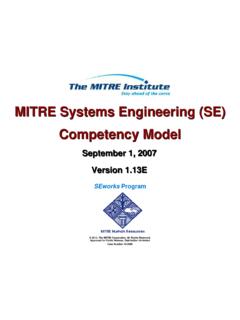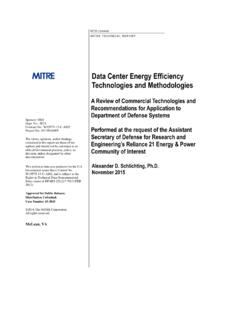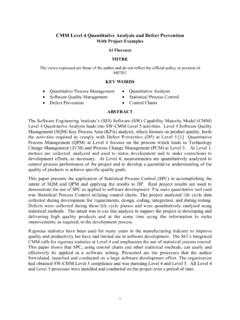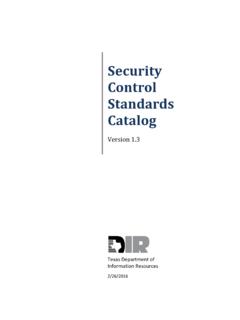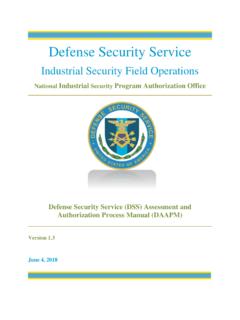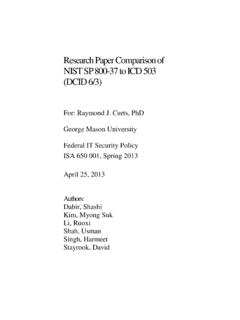Transcription of Cyber Resiliency and NIST Special Publication 800-53 Rev.4 ...
1 2013 The MITRE Corporation. Approved for Public Release; Distribution Unlimited. 13-4047 Cyber Resiliency and NIST Special Publication 800-53 Controls Deb Bodeau Richard Graubart September 2013 MITRE TECHNICAL REPORT MTR130531 Sponsor: NIST Dept. No.: G020 Project No.: 19128454-CA MTR130531 The views, opinions and/or findings contained in this report are those of The MITRE Corporation and should not be construed as an official government position, policy, or decision, unless designated by other documentation. 2013 The MITRE Corporation. All rights reserved. Bedford, MA iii 2013 The MITRE Corporation.
2 Approved for Public Release; Distribution Unlimited. 13-4047 Abstract Attacks in cyberspace are no longer limited to simple discrete events such as the spread of a virus or a denial-of-service attack against an organization. Campaigns are waged by the advanced persistent threat (APT), which has the capabilities, resources and persistence to breach even well patched and monitored IT infrastructures. Therefore, today s systems must be resilient against the APT. MITRE has developed its Cyber resilience engineering framework (CREF) to support the development of structured and consistent Cyber Resiliency guidance. The CREF consists of goals, objectives and techniques.
3 In the context of the Risk Management Framework defined by NIST sp 800 -37, Cyber Resiliency techniques can be applied to a system, set of shared services, or common infrastructure by selecting, tailoring, and implementing security controls. This document identifies those controls in NIST sp 800 -53R4 that support Cyber Resiliency . iv 2013 The MITRE Corporation. Approved for Public Release; Distribution Unlimited. 13-4047 This page intentionally left blank. v 2013 The MITRE Corporation. Approved for Public Release; Distribution Unlimited. 13-4047 vi 2013 The MITRE Corporation. Approved for Public Release; Distribution Unlimited.
4 13-4047 Table of Contents 1 Introduction .. 1 Distinguishing Characteristics of the APT .. 2 2 MITRE s Cyber Resiliency Framework .. 4 3 Selecting NIST sp 800 -53R4 Controls that Support Cyber Resiliency Techniques .. 9 Appendix A Mapping Resiliency Techniques to NIST SP 800-53 R4 Controls .. 11 Appendix B References .. 37 vii 2013 The MITRE Corporation. Approved for Public Release; Distribution Unlimited. 13-4047 List of Figures Figure 1. Structure of a Cyber Campaign .. 1 Figure 2. Cyber Resiliency Engineering Framework .. 4 viii 2013 The MITRE Corporation. Approved for Public Release; Distribution Unlimited.
5 13-4047 List of Tables Table 1. Cyber Resiliency Goals .. 4 Table 2. Cyber Resiliency Objectives .. 5 Table 3. Cyber Resiliency Techniques .. 7 Table 4. Mapping Cyber Resiliency Techniques to Objectives .. 8 1 2013 The MITRE Corporation. Approved for Public Release; Distribution Unlimited. 13-4047 1 Introduction Missions, business functions, organizations, and nations are increasingly dependent on cyberspace. Attacks in cyberspace are no longer limited to simple (albeit significantly harmful) discrete events such as the spread of a virus or worm, or a denial-of-service attack against an organization. Campaigns are waged by the advanced persistent threat (APT), following a Cyber attack lifecycle1 as illustrated in Figure 1 [1] [2].
6 Campaigns involve stealthy, persistent, and sophisticated activities, to establish a foothold in organizational systems, maintain that foothold and extend the set of resources the adversary controls, and exfiltrate sensitive information or disrupt operations. Figure 1. Cyber Attack Lifecycle Organizations increasingly recognize that missions, business functions, systems, systems-of-systems, and mission segments need to be resilient in the face of the APT. Many organizations are adopting the multi-tier approach to risk management described in NIST Special Publication (SP) 800-39 [3], and the security lifecycle approach to risk management defined by the Risk Management Framework (RMF) in NIST sp 800 -37 [4].
7 For those organizations, the question arises: How should security controls (or control enhancements) in NIST sp 800 -53R4 [5] be selected, tailored, and implemented to improve Cyber Resiliency ?2 This technical report identifies controls in NIST sp 800 -53R4 that support Cyber Resiliency . The controls are characterized in terms of the Resiliency techniques identified in MITRE s Cyber Resiliency Engineering Framework (CREF) [6]; Section 2 provides a brief overview of the CREF. Section 3 identifies factors to consider when selecting, tailoring, or implementing controls to improve Cyber Resiliency . The bulk of the document is in the Appendix, which identifies Resiliency -related controls, provides the text of each control (or control enhancement), and maps the control or enhancement to the relevant Cyber Resiliency technique(s).
8 1 The Cyber Attack Life Cycle, is a modification of what Lockheed Martin referred to as the Cyber kill chain [13] [14]. 2 Information security risk management considers a wide range of possible threats, including environmental ( , natural disaster), structural ( , equipment failure), accidental, and adversarial [12]. Historically, descriptions of adversarial threats have focused on singular events by outsiders ( , intrusions, denial-of-service attacks), or on persistent abuses of access by insiders. The control baselines in NIST sp 800 -53R4 address such adversarial threats, as well as environmental, structural, and accidental threats.
9 However, as noted in Section of NIST sp 800 -53R4, the control baselines do not address the APT. 2 2013 The MITRE Corporation. Approved for Public Release; Distribution Unlimited. 13-4047 The rest of this introductory section discusses the characteristics of the APT that make this threat different from threats that have historically been the focus of information security risk management. Distinguishing Characteristics of the APT NIST SP 800-53 R4 [5] defines the APT as An adversary that possesses sophisticated levels of expertise and significant resources which allow it to create opportunities to achieve its objectives by using multiple attack vectors ( , Cyber , physical, and deception).
10 These objectives typically include establishing and extending footholds within the information technology infrastructure of the targeted organizations for purposes of exfiltrating information, undermining or impeding critical aspects of a mission, program, or organization; or positioning itself to carry out these objectives in the future. The advanced persistent threat: (i) pursues its objectives repeatedly over an extended period of time; (ii) adapts to defenders efforts to resist it; and (iii) is determined to maintain the level of interaction needed to execute its objectives. Given the APT s expertise, resources, and persistence, even with correct implementation of all the necessary perimeter-based security, and continuous monitoring to ensure that patches are applied and vulnerabilities are closed, advanced adversaries will still breach the IT infrastructure [7].

